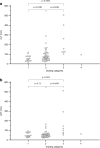The influence of hepatitis B and C virus coinfection on liver histopathology in children
- PMID: 25172445
- PMCID: PMC4334106
- DOI: 10.1007/s00431-014-2402-7
The influence of hepatitis B and C virus coinfection on liver histopathology in children
Abstract
The influence of hepatitis B virus (HBV) and hepatitis C virus (HCV) coinfection on liver histology in children remains unknown. We analyzed histopathological features in 70 treatment-naïve children: 10 with HBV/HCV coinfection (case group A), 30 with HBV (control group B), and 30 with HCV (control group C). Liver biopsies were scored for grading and staging according to Knodell's modified system and were tested for an association with demographic and laboratory data. The mean grade was higher in coinfected children compared to control group C (6.2 ± 3.0 vs. 4.2 ± 2.5, p = 0.04), but not control group B (p = 0.47). A higher proportion of patients with moderate to severe necroinflammation were observed in case group A compared to isolated HCV (p = 0.05). Mean staging did not differ between the case and control groups. Multivariate analysis revealed that HBV/HCV coinfection and aminotransferase activity were independently associated with moderate to severe necroinflammatory activity Conclusion: HBV/HCV coinfection was associated with moderate to severe necroinflammation irrespective of age at biopsy or duration of infection and led to significantly higher necroinflammatory activity than HCV monoinfection. HBV/HCV coinfection did not enhance fibrosis. High aminotransferase levels were positively associated with moderate to severe necroinflammation.
Figures



Similar articles
-
Hepatitis B and Hepatitis C Virus Infection Promote Liver Fibrogenesis through a TGF-β1-Induced OCT4/Nanog Pathway.J Immunol. 2022 Feb 1;208(3):672-684. doi: 10.4049/jimmunol.2001453. Epub 2022 Jan 12. J Immunol. 2022. PMID: 35022275 Free PMC article.
-
Hepatitis B virus infection in Chinese patients with hepatitis C virus infection: prevalence, clinical characteristics, viral interactions and host genotypes: a nationwide cross-sectional study.BMJ Open. 2016 Oct 12;6(10):e012016. doi: 10.1136/bmjopen-2016-012016. BMJ Open. 2016. PMID: 27733412 Free PMC article.
-
Replication Inhibition of Hepatitis B Virus and Hepatitis C Virus in Co-Infected Patients in Chinese Population.PLoS One. 2015 Sep 30;10(9):e0139015. doi: 10.1371/journal.pone.0139015. eCollection 2015. PLoS One. 2015. PMID: 26422607 Free PMC article.
-
Coinfection of Schistosoma Species with Hepatitis B or Hepatitis C Viruses.Adv Parasitol. 2016;91:111-231. doi: 10.1016/bs.apar.2015.12.003. Epub 2016 Feb 5. Adv Parasitol. 2016. PMID: 27015949 Review.
-
Epidemiology, natural history, and treatment of hepatitis B virus and hepatitis C virus coinfection.Minerva Gastroenterol Dietol. 2006 Jun;52(2):145-55. Minerva Gastroenterol Dietol. 2006. PMID: 16557186 Review.
Cited by
-
HBV-HCV Coinfection: Viral Interactions, Management, and Viral Reactivation.J Clin Transl Hepatol. 2018 Sep 28;6(3):296-305. doi: 10.14218/JCTH.2018.00016. Epub 2018 Jul 6. J Clin Transl Hepatol. 2018. PMID: 30271742 Free PMC article. Review.
-
Coinfections of the Respiratory Tract: Viral Competition for Resources.PLoS One. 2016 May 19;11(5):e0155589. doi: 10.1371/journal.pone.0155589. eCollection 2016. PLoS One. 2016. PMID: 27196110 Free PMC article.
-
What's new in hepatitis C virus infections in children?World J Gastroenterol. 2015 Oct 14;21(38):10783-9. doi: 10.3748/wjg.v21.i38.10783. World J Gastroenterol. 2015. PMID: 26478670 Free PMC article. Review.
-
Switching to PegIFNα-2b leads to HBsAg loss in patients with low HBsAg levels and HBV DNA suppressed by NAs.Sci Rep. 2017 Oct 17;7(1):13383. doi: 10.1038/s41598-017-13747-9. Sci Rep. 2017. PMID: 29042662 Free PMC article. Clinical Trial.
-
Is liver biopsy still needed in children with chronic viral hepatitis?World J Gastroenterol. 2015 Nov 14;21(42):12141-9. doi: 10.3748/wjg.v21.i42.12141. World J Gastroenterol. 2015. PMID: 26576098 Free PMC article. Review.
References
MeSH terms
Substances
LinkOut - more resources
Full Text Sources
Other Literature Sources
Medical

